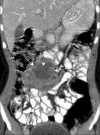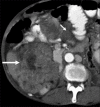CT features, mimics and atypical presentations of gastrointestinal stromal tumor (GIST)
- PMID: 22013291
- PMCID: PMC3190488
- DOI: 10.4103/0971-3026.85364
CT features, mimics and atypical presentations of gastrointestinal stromal tumor (GIST)
Abstract
The term stromal tumor was coined in 1983 by Clark and Mazur for smooth muscle neoplasm of the gastrointestinal tract (GIT). Gastrointestinal stromal tumors (GIST) are nonepithelial tumors arising from the interstitial cells of Cajal, which express KIT protein-CD117 on immunohistochemistry. GIST can arise anywhere in the GIT, including the mesentery, omentum, and retroperitoneum.
Keywords: Exophytic; GIST; immunohistochemistry.
Conflict of interest statement
Figures













Similar articles
-
Gastrointestinal stromal tumors/smooth muscle tumors (GISTs) primary in the omentum and mesentery: clinicopathologic and immunohistochemical study of 26 cases.Am J Surg Pathol. 1999 Sep;23(9):1109-18. doi: 10.1097/00000478-199909000-00015. Am J Surg Pathol. 1999. PMID: 10478672
-
[Clinicopathological and immunohistochemical study of extra-gastrointestinal stromal tumors arising from the omentum and mesentery].Zhonghua Bing Li Xue Za Zhi. 2005 Jan;34(1):11-4. Zhonghua Bing Li Xue Za Zhi. 2005. PMID: 15796875 Chinese.
-
[Gastrointestinal stromal tumors: conceptual evolution].Rev Fac Cien Med Univ Nac Cordoba. 2006;63(1):37-45. Rev Fac Cien Med Univ Nac Cordoba. 2006. PMID: 17639807 Review. Spanish.
-
A rare case of extraperitoneal gastrointestinal stromal tumor arising from kidney.Indian J Urol. 2020 Apr-Jun;36(2):133-135. doi: 10.4103/iju.IJU_251_19. Epub 2020 Apr 7. Indian J Urol. 2020. PMID: 32549666 Free PMC article.
-
[Gastrointestinal stromal tumors].Vojnosanit Pregl. 2002 Mar-Apr;59(2):183-202. Vojnosanit Pregl. 2002. PMID: 12053473 Review. Serbian.
Cited by
-
Prediction of High-Risk Gastrointestinal Stromal Tumor Recurrence Based on Delta-CT Radiomics Modeling: A 3-Year Follow-up Study After Surgery.Clin Med Insights Oncol. 2024 Apr 15;18:11795549241245698. doi: 10.1177/11795549241245698. eCollection 2024. Clin Med Insights Oncol. 2024. PMID: 38628841 Free PMC article.
-
Duodenal bulb tumour of unknown origin.Prz Gastroenterol. 2014;9(6):365-70. doi: 10.5114/pg.2014.47900. Epub 2014 Dec 30. Prz Gastroenterol. 2014. PMID: 25653733 Free PMC article.
-
A pictorial review on clinicopathologic and radiologic features of duodenal gastrointestinal stromal tumors.Diagn Interv Radiol. 2020 Jul;26(4):277-283. doi: 10.5152/dir.2019.19432. Diagn Interv Radiol. 2020. PMID: 32558653 Free PMC article. Review.
-
Understanding Gastric GIST: From Pathophysiology to Personalized Treatment.J Clin Med. 2024 Jul 9;13(14):3997. doi: 10.3390/jcm13143997. J Clin Med. 2024. PMID: 39064037 Free PMC article. Review.
-
Abdominal Hernias, Giant Colon Diverticulum, GIST, Intestinal Pneumatosis, Colon Ischemia, Cold Intussusception, Gallstone Ileus, and Foreign Bodies: Our Experience and Literature Review of Incidental Gastrointestinal MDCT Findings.Biomed Res Int. 2017;2017:5716835. doi: 10.1155/2017/5716835. Epub 2017 May 30. Biomed Res Int. 2017. PMID: 28638830 Free PMC article. Review.
References
-
- Burkill GJ, Badran M, Al-Muderis O, Meirion Thomas J, Judson IR, Fisher C, et al. Malignant gastrointestinal stromal tumor: Distribution, imaging features, and pattern of metastatic spread. Radiology. 2003;226:527–32. - PubMed
-
- Miettinen M, Lasota J. Gastrointestinal stromal tumors: Definition, clinical, histological, immunohistochemical, and molecular genetic features and differential diagnosis. Virchows Arch. 2001;438:1–12. - PubMed
-
- Ludwig DJ, Traverso LW. Gut stromal tumors and their clinical behavior. Am J Surg. 1997;173:390–4. - PubMed
-
- Miettinen M, Monihan JM, Sarlomo-Rikala M, Kovatich AJ, Carr NJ, Emory TS, et al. Gastrointestinal stromal tumors/smooth muscle tumors (GISTs) primary to the omentum and mesentery. Am J Surg Pathol. 1999;23:1109–18. - PubMed
-
- Fletcher CD, Berman JJ, Corless C, Gorstein F, Lasota J, Longley BJ, et al. Diagnosis of gastrointestinal stromal tumors: A consensus approach. Hum Pathol. 2002;33:459–65. - PubMed
LinkOut - more resources
Full Text Sources

